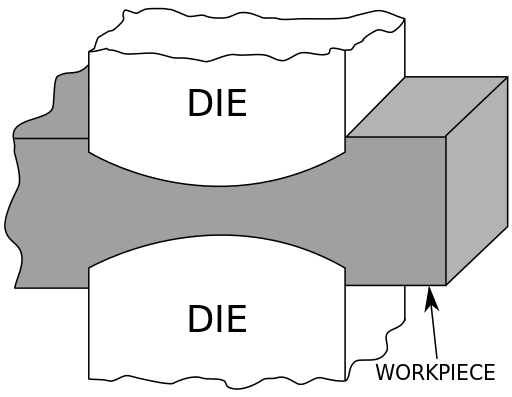
Forging is an essential industry that keeps society up and running.
It’s done via many different processes, one of which being closed die forging. This method is incredibly effective at creating near-finished parts and is also used to create more complex geometric shapes from various metals.
So how does this process work and what are its real-life applications?
Here’s the lowdown on closed die forging; how it’s done and what it’s used for.
Why closed die forging?
Closed Die Forging – also known as impression forging is a method of forging that forces the heated malleable metal into a die or mould that is then hammered so the metal fills the die cavities.
As opposed to cast-forging, welding, or other forging processes, closed die drop forging takes advantage of the natural grain of the metal and creates a component out of a single piece of metal rather than welding two together.
The closed die forging process
Multiple different shapes and sizes can be forged from small fittings to large pieces. Here’s a step by step guide to how it’s done:
1. A mould is created to determine the shape of the product. Closed die forging companies will use Computer-Aided Design (CAD) to create 3-dimensional rendering of the final product to ensure the right dimensions before putting metal on metal.
2. The next step involves cutting the dies to shape. Dies are made out of the toughest steel which can withstand both extreme temperatures and the stress of the forging process.
3. The correct steel specification is selected based on the type of product and its function.
4. Do a trial run. Forging a sample is necessary to ensure the mould is producing the right dimensions. This is a chance to carry out any necessary adjustments.
5. Once everything is set, a full production run can take place. The metal is heated, forged, trimmed until a near-perfect or perfect shape is created.
6. Treatments are then applied depending on the required properties. Such treatments can include tempering and hardening, heat treatment, and other surface treatments such as hot-dip galvanising or powder coating.
What metals are used in closed die forging?
Depending on the purpose, use, and other product characteristics, various different metals are used. Here are some of the most common materials used in closed die forging:
Stainless steel
One of the most common metals in closed die forging, stainless steel is used when a product requires corrosion and rust resistance, such as parts on a naval ship.
Alloy Steel
Alloy steel is another common metal type used by various industries for products that need to be lightweight, easily moulded, yet also highly robust and durable.
Carbon Steel
Carbon steel is an extremely versatile material and is available in a variety of different grades which can be heat-treated to improve wear and impact resistance.
Aluminium
Aluminum is a low-density metal and can be easily machined. It is highly sought after in the automotive and aerospace industries.
Brass and Copper
Although on the more expensive side, these metals are often used in closed die forging to create fittings, valves, and bearings.
Closed die forging applications
Closed die forging can produce a wide variety of geometrical shapes and specifications en masse. It’s therefore indispensable to a vast array of industries in every corner of the globe.
Here are some of the industries where closed die forging makes a big difference:
Automotive
Closed die forging methods are geared towards producing high volumes at comparatively lower costs. The automotive industry relies heavily on closed die forging methods to produce multiple car parts such as axle beams, connecting rods, and steering yolks.
Civil
From construction to landscaping and utilities, closed die forging supports contractors and builders in replacement parts, excavator bucket teeth, forged shafts, cylinders, and rollers.
Forestry and Agriculture
From gears to spike harrow heads and shackles, closed die forging is responsible for multiple agricultural and forestry solutions. Compared to alternative methods, closed die forging can produce extremely durable components at a high capacity. For forestry and agricultural specialists, the need for highly durable and stress-resistant components makes closed die forging the preferred solution.
Mining
Whether it’s iron ore, natural gas, or oil, the application of closed die forging methods is enormous. High-strength and near-perfect finish on drive gears, disks, bucket pins, and cylinders, give closed die forging the edge over other methods.
Marine
The marine industry requires metal hardware to reach tight tolerances and maximum durability able to withstand years of use in extreme environments.
Closed die forging offers the best solution for large-scale projects with big production capacity. From boats, docks, and anchor links – marine grade metal components frequently make up a large portion of closed die forging operations.
Military, Defence, and Aerospace
Closed die forging produces high-grade, near-net-shape components for armoured vehicles, tanks, satellites, and rockets. These parts naturally must be of the highest quality to withstand combat situations.
Need forged components? Fire up your next project with the experts. Get in contact with one of Australia’s closed die forging companies for end-to-end project delivery and unmatched quality.